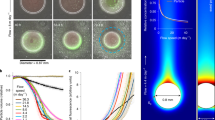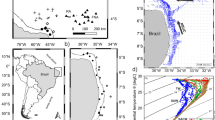Abstract
This paper synthesizes current ideas on the role of the microbial loop in carbon fluxes in the ocean and proposes some directions for future research. Organic matter flux into bacteria is highly variable, which can significantly influence the pathways of carbon flow in the ocean. A goal for future research is to elucidate the mechanistic bases of bacteria-organic matter coupling. This research should take into consideration the micrometer-scale distribution of bacteria and the composition, structure, and dynamics of the organic matter field in the bacterium's microhabitat. The ideas on the interactions of bacteria with the particulate organic phase need to be revised in view of recent findings of highly abundant, previously unknown particles ranging in size from nanometers to hundreds of micrometers. The “hot-spots” in the distribution of organic matter and remineralized nutrients can influence the rates as well as the direction of biogeochemical fluxes. Slow-to-degrade dissolved organic matter (DOM) may be produced because of loose bacteria-organic matter coupling resulting in DOM storage. Its use at a later time and place has profound implications for carbon fluxes and food web dynamics. A fundamental research need for the future is to understand the ecological interactions among the members of the microbial loop in an appropriate microhabitat context. While this goal was previously intractable, new molecular and optical techniques should make it possible to understand the biogeochemical activities of the microbial loop in terms of the ecology and evolution of pelagic microbial communities.
Similar content being viewed by others
References
Alldredge AL, Cohen Y (1987) Can microscale chemical patches persist in the sea? Microelectrode study of marine snow, fecal pellets. Science 235:689–691
Alldredge AL, Gotschalk CC (1990) The relative contribution of marine snow of different origins to biological processes in coastal waters. Cont Shelf Res 10:41–58
Alldredge AL, Passow U, Logan BE (1993) The abundance and significance of a class of large, transparent organic particles in the ocean. Deep-Sea Res 40:1131–1140
Andersson A, Larsson U, Hagström Å (1986) Size-selective grazing by a microflagellate on pelagic bacteria. Mar Ecol Prog Ser 33:51–57
Azam F, Ammerman JW (1984) Cycling of organic matter by bacterioplankton in pelagic marine ecosystems: microenvironmental considerations. In: Fasham MJR (ed) Flows of energy and materials in marine ecosystems. Plenum Publishing, New York, pp 345–360
Azam F, Hodson RE (1977) Size distribution and activity of marine microheterotrophs. Limnol Oceanogr 22:492–501
Azam F, Hodson RE (1981) Multiphasic kinetics for D-glucose uptake by assemblages of natural marine bacteria. Mar Ecol Prog Ser 6:213–222
Azam F, Smith DC (1991) Bacterial influence on the variability in the ocean's biogeochemical state: a mechanistic view. In: Demers S (ed) Particle analysis in oceanography. Springer-Verlag, Berlin pp 213–236
Azam F, Fenchel T, Field JG, Gray JS, Meyer-Reil LA, Thingstad F (1983) The ecological role of water-column microbes in the sea. Mar Ecol Prog Ser 10:257–263
Azam F, Smith DC, Hollibaugh JT (1991) The role of the microbial loop in Antarctic pelagic ecosystems. Polar Res 10:239–243
Azam F, Smith DC, Carlucci AF (1992) Bacterial transformation and transport of organic matter in the Southern California Bight. Prog Oceanogr 30:151–166
Azam F, Martinez J, Smith DC (1993) Bacteria—organic matter coupling on marine aggregates. In: Guerrero R, Pedrós-Alió C (ed) Trends in microbial ecology. Spanish Society for Microbiology, Barcelona, pp 410–414
Benner R, Pakulski JD, McCarthy M, Hedges JI, Hatcher PG (1992) Bulk chemical characteristics of dissolved organic matter in the ocean. Science 255:1561–1564
Berman T, Stiller M (1977) Simultaneous measurement of phosphorus and carbon uptake in Lake Kinneret by multiple isotopic labeling and differential filtration. Microb Ecol 3:279–288
Biddanda BA, Pomeroy LR (1988) Microbial aggregation and degradation of phytoplankton-derived detritus in seawater. I. Microbial succession. Mar Ecol Prog Ser 42:79–88
Bowen JD, Stolzenbach KD, Chisholm SW (1993) Simulating bacterial clustering around phytoplankton cells in a turbulent ocean. Limnol Oceanogr 38:36–51
Cho BC, Azam F (1988) Major role of bacteria in biogeochemical fluxes in the ocean's interior. Nature 332:441–443
Chróst RJ (1991) Microbial enzymes in aquatic environments. Springer-Verlag, New York
Dawson R, Gocke K (1978) Heterotrophic activity in comparison to the free amino acid concentrations in Baltic Sea water samples. Oceanol Acta 1:45–54
DeLong EF, Wickham GS, Pace NR (1989) Phylogenetic stains: ribosomal RNA-based probes of the identification of single cells. Science 243:1360–1363
DeLong EF, Franks DG, Alldredge AL (1993) Phylogenetic diversity of aggregate-attached vs. free-living marine bacterial assemblages. Limnol Oceanogr 38:924–934
Ducklow HW (1993) Bacterioplankton distributions and production in the northwestern Indian Ocean and Gulf of Oman. Deep-Sea Res 40:753–771
Ducklow HW, Kirchman DL, Rowe GT (1982) Production and vertical flux of attached bacteria in the Hudson River plume of the New York Bight as studied with floating sediment taps. Appl Environ Microbiol 43:769–776
Ducklow HW, Kirchman DL, Quinby HL, Carlson CA, Dam HG (1993) Stocks and dynamics of bacterioplankton carbon during the spring bloom in the eastern North Atlantic Ocean. Deep-Sea Res II 40:245–263
Fuhrman J (1992) Bacterioplankton roles in cycling of organic matter: the microbial food web. In: Falkowski PG, Woodhead AD (ed) Primary productivity and biogeochemical cycles in the sea. Plenum Press, New York, pp 361–383.
Fuhrman JA, Azam F (1980) Bacterioplankton secondary production estimates for coastal waters of British Columbia, Antarctica, and California. Appl Environ Microbiol 39:1085–1095
Fuhrman JA, Eppley RW, Hagström Å, Azam F (1985) Diel variations in bacterioplankton, phytoplankton, and related parameters in the Southern California Bight. Mar Ecol Prog Ser 27:9–20
Gale EF (1952) The chemical activities of bacteria. Academic Press, New York
González JM, Suttle CA (1993) Grazing by marine nanoflagellates on viruses and virus-sized particles: ingestion and digestion. Mar Ecol Prog Ser 94:1–10
Hagström Å, Larsson U, Hörstedt P, Normark S (1979) Frequency of dividing cells, a new approach to the determination of bacterial growth rates in aquatic environments. Appl Environ Microbiol 37:805–812
Hebel D, Knauer GA, Martin JH (1986) Trace metals in large agglomerates (marine snow). J Plankton Res 8:819–824
Heldal M, Bratbak G (1991) Production and decay of viruses in aquatic environments. Mar Ecol Prog Ser 72:205–212
Hobbie JE, Daley RJ, Jasper S (1977) Use of Nuclepore filters for counting bacteria by epifluorescence microscopy. Appl Environ Microbiol 33:1225–1228
Hollibaugh J, Fuhrman J, Azam F (1980) Radioactively labeling of natural assemblages of bacterioplankton for use in trophic studies. Limnol Oceanogr 25:172–181
Hollibaugh JT, Wong PS, Azam F, Smith DC, Steward GF, Cole BE (1992) Measurement of bacterioplankton production in Antarctic coastal waters: comparison of thymidine and l-leucine methods and verification of labeling patterns. Antarc J U S 27:127–128
Jannasch HW, Pritchard PH (1972) The role of inert particulate matter in the activity of aquatic microorganisms. Mem Ist Ital Idrobiol 29(s):289–305
Karl DM, Knauer GA, Martin JH, Ward BB (1984) Bacterial chemolithotrophy in association with sinking particles. Nature 309:54–56
Karl DM, Knauer GA, Martin JH (1988) Downward flux of particulate organic matter in the ocean: a particle decomposition paradox. Nature 332:438–441
Karner M, Herndl G (1992) Extracellular enzymatic activity and secondary production in free-living and marine-snow-associated bacteria. Mar Biol 113:341–347
Keil RG, Kirchman DL (1993) Dissolved combined amino acids: chemical form and utilization by marine bacteria. Limnol Oceanogr 38:1256–1270
Kepkay PE, Johnson BD (1988) Microbial response to organic particle generation by surface coagulation in seawater. Mar Ecol Prog Ser 48:193–198
King KR, Hollibaugh JT, Azam F (1980) Predator-prey interactions between the larvacean Oikopleura dioica and bacterioplankton in enclosed water columns. Mar Biol 56:49–57
Kirchman DL, Mitchell R (1982) Contribution of particle-bound bacteria to total microheterotrophic activity in five ponds and two marshes. Appl Environ Microbiol 43:200–209
Kirchman DL, Suzuki Y, Garside C, Ducklow HW (1991) High turnover rates of dissolved organic carbon during a spring phytoplankton bloom. Nature 352:612–614
Koike I, Shigemitsu H, Kazuki T, Kogure K (1990) Role of sub-micrometre particles in the ocean. Nature 345:242–244
Laanbroek HJ, Verplanke JC, Visscher PRMd, Vuyst RD (1985) Distribution of phyto- and bacterioplankton growth and biomass parameters, dissolved inorganic nutrients, and free amino acids during a spring bloom in the Oosterschelde basin, The Netherlands. Mar Ecol Prog Ser 25:1–11
Martinez J, Azam F (1993) Periplasmic aminopeptidase and alkaline phosphatase activities in a marine bacterium: implications for substrate processing in the sea. Mar Ecol Prog Ser 92:89–97
Mopper K, Zhou XL, Kieber RJ, Kieber DJ, Sikorski RJ, Jones RD (1991) Photochemical degradation of dissolved organic carbon and its impact on the oceanic carbon cycle. Nature 353:60–62
Pomeroy LR (1974) The ocean's food web, a changing paradigm. BioScience 24:499–504
Pomeroy LR, Deibel D (1986) Temperature regulation of bacterial activity during the spring bloom in Newfoundland coastal waters. Science 233:359–361
Pomeroy LR, Wiebe WJ, Deibel D, Thompson RJ, Rowe GT, Pakulski JD (1991) Bacterial responses to temperature and substrate concentration during the Newfoundland spring bloom. Mar Ecol Prog Ser 75:143–159
Proctor LM, Fuhrman JA (1990) Viral mortality of marine bacteria and cyanobacteria. Nature 343:60–62
Proctor LM, Fuhrman JA (1992) Mortality of marine bacteria in response to enrichments of the virus size fraction from seawater. Mar Ecol Prog Ser 87:283–293
Rehnstam A-S, Bäckman S, Smith DC, Azam F, Hagström Å (1993) Blooms of sequence-specific culturable bacteria in the sea. FEMS Microb Ecol 102:161–166
Sarmiento JL, Toggweiler JR, Najjar R (1988) Ocean carbon-cycle dynamics and atmospheric pCO2. Phil Trans R Soc Lond 325:3–21
Shanks AL, Trent JD (1979) Marine snow: microscale nutrient patches. Limnol Oceanogr 24:850–854
Shanks AL, Reeder ML (1993) Reducing microzones and sulfide production in marine snow. Mar Ecol Prog Ser 96:43–47
Sherr BF, Sherr EB, Fallon RD (1987) Use of monodispersed, fluorescently labeled bacteria to estimate in situ protozoan bacterivory. Appl Environ Microbiol 53:958–965
Sherr EB (1988) Direct use of high molecular weight polysaccharide by heterotrophic flagellates. Nature 335:348–351
Smith DC, Simon M, Alldredge AL, Azam F (1992) Intense hydrolytic enzyme activity on marine aggregates and implications for rapid particle dissolution. Nature 359:139–142
Steele JH (1974) The structure of marine ecosystems. Harvard Univ. Press, Cambridge
Toggweiler JR (1989) Is the downward dissolved organic matter (DOM) flux important in carbon transport? In: Berger WH, Smetacek VS, Wefer G (ed) Productivity of the ocean: present and past. John Wiley & Sons Limited, New York, pp 65–83
Wells ML, Goldberg ED (1991) Occurance of small colloids in sea water. Nature 353:342–344
Wheeler PA, Kirchman DL (1986) Utilization of inorganic and organic nitrogen by bacteria in marine systems. Limnol Oceanogr 31:998–1009
Wiebe WJ, Pomeroy LR (1972) Microorganisms and their association with aggregates and in the sea: a microscopic study. Mem Ist Ital Idrobiol 29:325–352
Wikner J, Hagström Å (1988) Evidence for a tightly coupled nanoplanktonic predator-prey link regulating the bacterivores in the marine environment. Mar Ecol Prog Ser 50:137–145
Williams P (1981) Microbial contributions to overall marine plankton metabolism: direct measurements of respiration. Oceanol Acta 4:359–370
Zweifel UL, Norrman B, Hagström Å (1993) Consumption of dissolved organic carbon by marine bacteria and demand for inorganic nutrients. Mar Ecol Prog Ser 101:23–32
Author information
Authors and Affiliations
Rights and permissions
About this article
Cite this article
Azam, F., Smith, D.C., Steward, G.F. et al. Bacteria-organic matter coupling and its significance for oceanic carbon cycling. Microb Ecol 28, 167–179 (1994). https://doi.org/10.1007/BF00166806
Issue Date:
DOI: https://doi.org/10.1007/BF00166806




